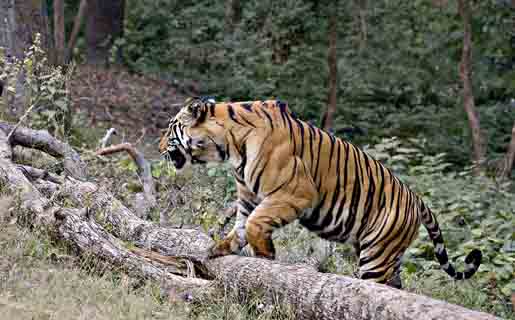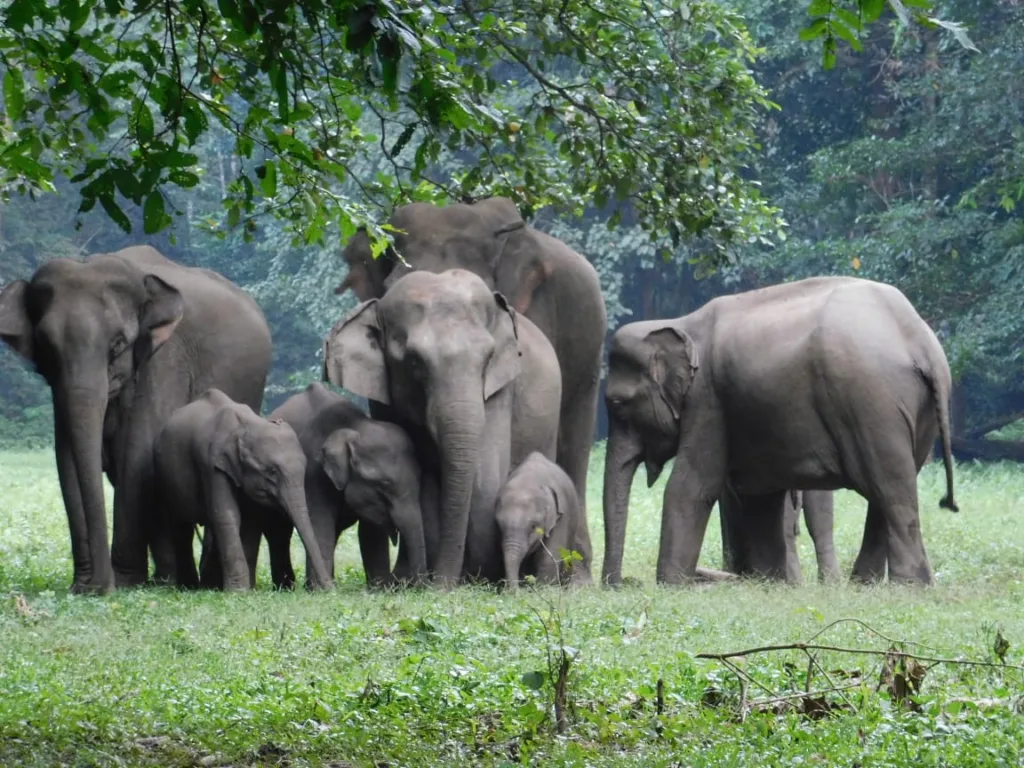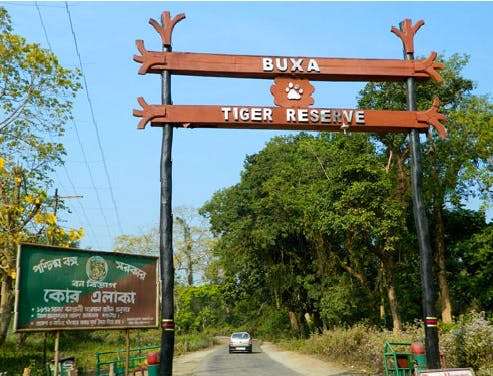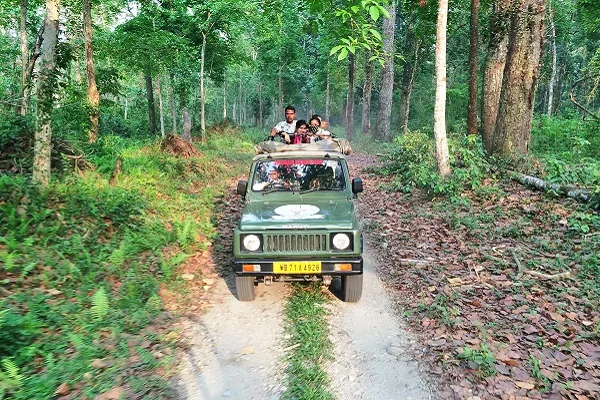Buxa Tiger Reserve or Buxa National Park
Once renowned for its dolomite mining activities, Buxa underwent a significant transformation, being designated as a tiger reserve in 1983 and attaining National Park status in 1992. Nestled on the Assam-Bhutan border, Buxa sprawls across an expansive 745 sq km, making it the largest forest in North Bengal. This biodiverse park hosts a myriad of wildlife, including a substantial population of elephants, Indian bison, leopards, various deer species, and numerous smaller mammals. Additionally, Buxa is a haven for birdwatchers and reptile enthusiasts, boasting a diverse array of avian and reptilian species. The park’s rich biodiversity extends to rare orchids and medicinal plants, contributing to its ecological significance. Some areas of the Buxa hills, particularly in the Sinchula range, remain unexplored due to challenging terrain.
With roots tracing back to antiquity, Buxa stands as one of the oldest settlements in North Bengal. Conveniently situated 24 km from Alipurduar and 180 km from Siliguri, the park is well-connected by both motorable roads and railways. Despite its name as a Tiger Reserve, spotting tigers in Buxa is a rare occurrence. Even local villagers, frequent visitors to the forest, seldom report tiger sightings. Although there are occasional claims of tiger presence, no concrete evidence has emerged. Some speculate that tigers from neighboring Bhutanese forests might venture into Buxa, but the park itself is believed to be devoid of resident tigers. Despite the forest department’s dismissal of this belief, there remains a lack of conclusive proof either way.

Trekking in and around Buxa Tiger Reserve offers a plethora of opportunities to explore its stunning natural beauty. Buxa Fort stands out as a favored destination for all types of travelers. The trek commences at Santarabari, covering a 5 km distance, ascending to Buxa Fort, which sits at an impressive elevation of 2844 ft above sea level. Beyond Buxa Fort lies Rover’s Point, a haven for avid birdwatchers, just 3 km further. For the more intrepid trekkers, a challenging 6 km journey takes you to Roopam Valley, situated at the border of Bhutan.
Lepchakhawa, a small yet picturesque valley, can be reached via a 5 km trek from Buxa Fort. Lepchakhawa treats trekkers to a breathtaking panorama of the entire Buxa Tiger Reserve, the plains of North Bengal, and the neighboring Bhutan. Adventurous souls can embark on a 13 km journey through dense forests, starting from Buxa Fort and culminating in Jayanti village within the Buxa Tiger Reserve. It’s essential to secure prior written permission from the forest department and be accompanied by an expert guide for this exhilarating route.
A shorter and easier 4 km trek leads to Pokhri Hill, beginning from Jayanti village within Buxa Tiger Reserve. For those seeking a spiritual and adventurous experience, the Mahakal Cave, a natural stalactite cave, is a mere 13 km from Jayanti in the Buxa Tiger Reserve. Additionally, Bhutai Basti, located 1.5 km away from Jayanti, offers an intriguing experience of the dense forest. The journey kicks off in Jayanti, crossing the Jayanti River and venturing through the thick Buxa forest. Bhutia Basti is also known as the “Den of Elephants.”
Jungle Safaris are immensely popular for visitors exploring the Buxa Tiger Reserve Forest. The Forest Department permits Jungle Safaris by Jeep in Jayanti and Rajabhatkhawa, allowing tourists to immerse themselves in the natural splendor of Buxa.



How To Reach Buxa?
The Buxa Tiger Reserve is situated around 200 kilometers away from Siliguri and is accessible via National Highway 31. It is approximately 30 kilometers from Alipurduar town. The closest railway station is Alipurduar Junction, with trains available from the New Jalpaiguri Railway Station in Siliguri. The nearest bus terminal is located in Siliguri, while the nearest airport is Bagdogra. Accommodation options are available in Jayanti, within or near the forest, as well as in the Rajabhatkhawa area, Santalabari area, and Raimatang.
What To See And Do In Buxa Tiger Reserve?
Buxa Tiger Reserve is a remarkable sanctuary, teeming with a rich tapestry of both flora and fauna. Among the diverse array of wildlife that calls this reserve home, you’ll encounter majestic creatures such as tigers, clouded leopards, various deer species, elephants, gaurs, wild dogs, pangolins, Himalayan black bears, civet cats, giant squirrels, mongooses, clawless otters, chital, sambar, buffalos, and red jungle fowl.
Moreover, the reserve is also a habitat for an impressive avian population, including Himalayan griffons, nutuch, hornbills, and red-breasted Himalayan partridges. Numerous small water bodies and ponds within the reserve house a wide variety of tortoises. Rare orchids and medicinal plants also thrive in this natural haven. Nearby, the Raidak and Jayanti rivers attract migratory birds like the Trans Himalayan Migratory Goosander, Ibis Bull, Red-stars, Fork-tails, Wag-tails, Teals, White Eyed Poachard, minivets, Sultan tits, and more. Notably, it’s a sanctuary for some of the rarest avian species, including Black Storks and Black-necked Cranes.
Reptiles like pythons and monitor lizards are also abundant in this region.
Buxa Tiger Reserve | Alipurduar District | India
Trek in Buxa: The trek begins at Santalabari and takes you through a 5-kilometer journey, ascending the hills and venturing through the forest. This trail leads to the Buxaduar Forest Bungalow. If you’re up for it, you can continue your journey another 4 kilometers to reach Rover’s Point, situated at an elevation of 4,500 feet. This point is often referred to as the “land of the unknown birds,” and from here, you can catch a glimpse of the Rupam Valley in Bhutan, located 12 kilometers away. Throughout your trek, you’ll be treated to stunning views of the Jayanti River Valley.
Explore the Enigmatic Mahakal Cave: At the culmination of your trek, you’ll arrive at Jayanti, home to the mysterious Mahakal Cave. This stalactite cave is a natural wonder, albeit narrow, damp, and dark. Explore it at your own risk. If you’re eager to continue your adventure, you can journey downhill to the Jayanti Forest Bungalow.
Visit Rajabhatkhawa: Located just 12 kilometers from Jayanti, Rajabhatkhawa is a popular tourist destination that can be seamlessly integrated into your Buxa Tiger Reserve itinerary. Surrounded by the reserve’s lush forests, this area offers abundant opportunities for wildlife enthusiasts. Rajabhatkhawa features a watchtower hidden deep within the jungle, providing a chance to spot elephants, bisons, and on rare occasions, tigers. Additionally, the place boasts The Nature Interpretation Centre and The Animal Rescue Centre. Visitors can also opt for a park safari, whether in a car or a jeep.
Buxa Tiger Reserve – Safari Booking, Timings and Entry Fee

Buxa Tiger Reserve Entry Fees –
For an enchanting journey through the lush wilderness of Buxa Tiger Reserve, visitors should start their adventure by entering the forest through the primary gate located in Rajabhatkhawa and securing an entry ticket. To embark on a Jeep safari, you’ll need to obtain a Safari Permit from the Jayanti Range Office, where you can also arrange for a knowledgeable guide. The Buxa Tiger Reserve Jeep safari covers a distance of approximately 17 kilometers, guiding you through the densely forested terrain.
The Buxa Tiger Reserve Jungle Safari offers two shifts to choose from. The first shift commences at 6 am and concludes at 11 am, allowing you to experience the beauty of the reserve in the morning. Another shift begins in the afternoon, starting at approximately 2 pm and ending at around 6 pm, providing a different perspective of the reserve’s natural splendor.
The cost of the Buxa Jungle Safari may vary over time, so for the most up-to-date pricing details, it is advisable to contact the authorities by calling the provided phone numbers.
Best Time To Visit In Buxa –
The optimal time to explore Buxa Tiger Reserve and its vicinity is between October and April. During these months, the weather is exceptionally pleasant, creating an ideal environment for a blissful Jungle Safari. Temperatures typically range between 12 degrees and 32 degrees Celsius, ensuring a comfortable experience.
It’s important to note that from 15th June to 15th September, the forest in the Dooars region is closed, making it inadvisable to visit Buxa Tiger Reserve during this period. Moreover, the Jungle Safari within the Buxa forest will also be unavailable as it remains closed during these months.
